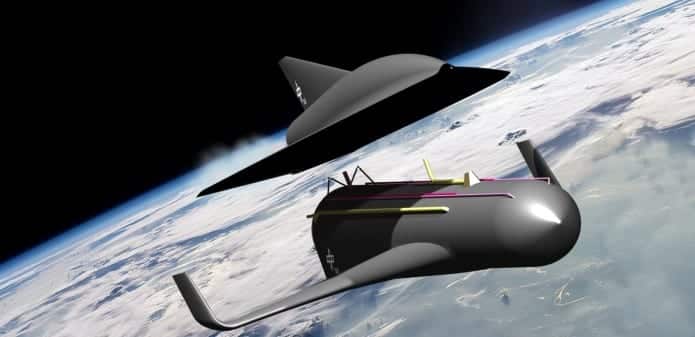German space researchers working on launching hypersonic space plane by 2030
DLR researchers have rebooted their efforts of developing hyper-sonic passenger plane that would be boarded on suborbital space planes.
German aerospace research center, the Deutsches Zentrum für Luft- und Raumfahrt (DLR), is planning to revive a decade-old plan which aims at developing hyper-sonic flights by 2030.
Referred as SpaceLiner, it would carry 100 passengers and would be used to transport passengers from Europe to Australia in just 90 minutes.
Besides the journey between Europe to U.S. too would be made possible in just about 60 minutes, definitely it will be offered at a price.
The proposed hyper-sonic flight would travel 20 times the speed of sound. In the present scenario it would take around say 20 to 30 hours for a person to travel from Europe to Australia via normal air flight, so a SpaceLiner would definitely help people to save a lot of time.
The project is being led by Martin Sippel and he told Aviation Week at the AIAA – American Institute of Aeronautics & Astronautics conference in Glasgow, Scotland, that the plan was first proposed in 2007, almost a decade ago; however now the German researchers have resurrected the plan as they believe it is possible to build such a SpaceLiner in the next two decades.
Sippel said: “We want to come up with a development road map. We need a mission definition and this year we will do that in Phase A. To make it more viable, DLR has also outlined a 100-seat version capable of 1-hr. intercontinental and transpacific missions. It is expected tickets would cost hundreds of thousands of dollars. We have several hundred million passengers traveling intercontinental distances each year and we think space should have a tiny portion of that. But even if the share will only be 0.2% why should we do it? From a space perspective that’s a potentially huge impact.”
Table Of Contents
Working of the SpaceLiner:
Sippel explained that the working of the vehicle would be similar to that of an old Space Shuttle.
It would comprise of a fully reusable two stage system, namely passenger orbiter and the booster stage (rocket engine) which would be provided with an environment friendly rocket propulsion system which uses liquid hydrogen and oxygen for its fueling.
The passenger orbiter would board on the rocket engine and would be launched vertically. In a matter of just 10 minutes the engines of the SpaceLiner would get accelerated to more than 20 times the speed of the sound.
Once both of them reach a specific cruising altitude the passenger orbiter would get detached from the rocket engine and start gliding down into the atmosphere at Mach 20 which is 4.3 miles per second or Koro Sensei’s maximum speed, thus landing at its designated designation.
A tow air craft would hold up the rocket engine in the mid air before it gets autonomously landed at its destination.
According to the researchers, the SpaceLiner would take almost eight minutes to climb to an altitude of some 50 miles so as to reach the earth’s upper atmosphere from where it would glide back to Earth at a hyper-sonic speed of more than 15,000 mph.
Engineers at DLR are proposing to use a combination of liquid oxygen and hydrogen rocket fuel with water vapor as its end waste product.
With the advancement in material technology the SpaceLiner engineers hope to use newer cooling technologies to protect the structure of their SpaceLiner against intense heat produced by hypersonic flight.
Also engineers say that these SpaceLiner would require a careful planning of their route keeping in mind that passenger orbiter would land at very high speed and the booster stage would land autonomously.
Commercial SpaceLiner service will not commence at least until 2040:
Sippel says that the SpaceLiner can be used by the rich and elite as a means of fast transportation.
Besides, the reusable booster stage can also be used to ferry other vehicles to space or it can also be used to soft-launch satellite into higher orbit.
He said: “We could increase hundredfold the number of launches and, as it is a reusable vehicle designed for between 150 and 300 flights, you have serial production of engines,” Sippel continued, “If you have 11 engines per vehicle then you would build 2,000 engines per year or so. That’s a huge production run, and that was the motivation.”
However, at the current rate the estimated cost of developing the prototype of hyper-sonic SpaceLiner is nothing less than $33 billion also researchers propose it would have to undergo a multiple design reviews “before you build the first hardware in 2030,” Sippel said.
Eventually it seems the upcoming EU-funded study FAST20XX (Future High-Altitude High-Speed Transport 20xx) would also in a way affect the design of SpaceLiner. Besides, other space ventures such as Virgin Galactic too would affect the project of DLR. Sippel says that if the space travel really captures the interest of travelers then SpaceLiner could definitely make up to 15 flights per day.
He also added that the testing would involve up to six prototype vehicles and it will not be around 2040 that we will witness an actual commercial service.

